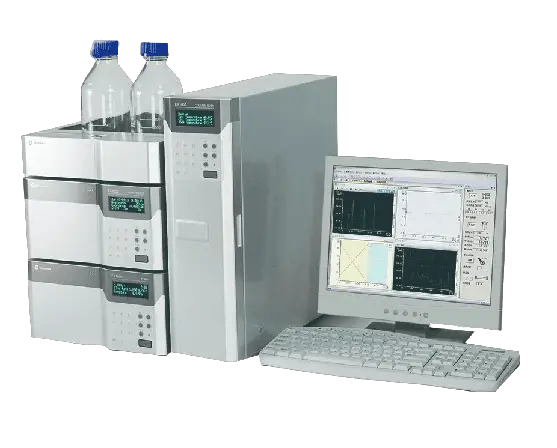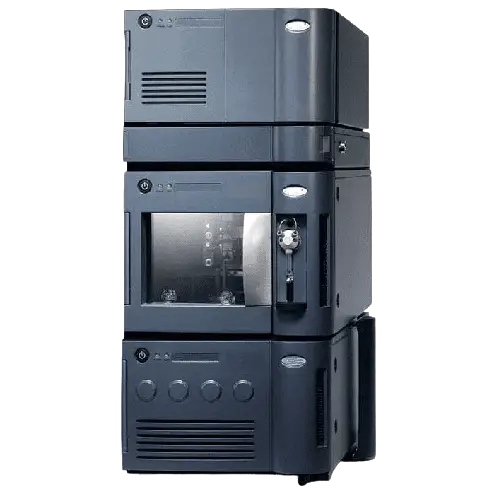WHAT IS HPLC?
High Performance Liquid Chromatography (HPLC), also known as high-pressure liquid chromatography, has become a widely used analytical technique in laboratories for the last 30 years. The HPLC system is built to endure and can handle pressures up to 6000 pounds per square inch (psi). This impressive capability allows for the precise separation of compounds, empowering scientists to uncover complex chemical secrets and make significant breakthroughs across different areas of research.
WHAT IS UPLC?
Ultra Performance Liquid Chromatography (UPLC) takes the stage as the cutting-edge successor to traditional HPLC. UPLC sets a new standard by boosting sample throughput, chromatographic efficiency, sensitivity, and reducing run time. The robust UPLC system can withstand pressures of up to an impressive 15,000 pounds per square inch (psi). This exceptional attribute enables scientists to achieve precise compound separation, leading to remarkable scientific progress and discoveries.
HPLC vs UPLC – WHAT ARE THE MAIN DIFFERENCES BETWEEN ?
HPLC and UPLC are two types of liquid chromatography techniques used for separating components within mixtures. While they share the same goal, there are notable differences between them. UPLC operates at higher pressures, reaching up to 15,000 pounds per square inch (psi), and employs columns with smaller particle sizes. In contrast, HPLC operates at lower pressures, typically below 6000 psi.
The higher pressures and smaller particle sizes in UPLC result in improved resolution and sensitivity of the analyses being separated. Additionally, UPLC enables lower consumption of solvents and shorter run times compared to HPLC. These advantages make UPLC a preferred choice for achieving higher efficiency and faster analysis in various scientific applications.
HPLC
High Performance Liquid Chromatography
- HPLC is one of the most dominant and widely used analytical technique in laboratories for the last 30 years
- In HPLC particle sizes of the stationary phase are typically in the order of 3-5 µm
- HPLC column has an internal diameter of 4.6 mm and a length of 250 mm
- Flow rates of HPLC is 1-2 ml/min
- Not required higher performance pumps and components as compare to UPLC
- HPLC is commonly used for applications like water purification and the detection of impurities in pharmaceuticals.
- Less costly
- well established method development available.
Vs
UPLC
Ultra Performance Liquid Chromatography
- UPLC is the cutting-edge and modern successor to traditional HPLC
- In UPLC particle sizes of the stationary phase are 2 µm or less.
- UPLC column has internal diameters of 2.1 mm or less up to 100 mm.
- Flow rates of UPLC is much lower flow rates than HPLC, for example 0.2 – 0.7 ml/min
- Shorter turnaround time (TAT), better resolution and higher sensitivity compared to HPLC methods.
- Narrow peaks are produced with UPLC
- UHPLC is more common in research and development
WHAT ARE THE APPLICATIONS HPLC vs UPLC?
HPLC is used for simpler applications like water purification and the detection of impurities in pharmaceuticals.
UHPLC finds greater prominence in research and development field. UPLC is primarily employed to identify and measure the individual components within complex samples. These samples can include substances like botanical extracts, dietary supplements, biological specimens, and more. By utilizing UPLC, scientists can effectively analyze and determine the presence and quantity of each component present in these intricate mixtures.
WHICH ONE IS MORE POPULAR BETWEEN HPLC vs UPLC?
Introduced in 1967, HPLC quickly gained popularity and became a staple in analytical laboratories from the 1980s to the early 2000s. However, the emergence of UPLC systems in the mid-2000s brought about enhanced flow rates, improved resolution, and faster analysis speeds. These advancements have propelled UPLC to the forefront, making it increasingly favored and sought-after as the preferred system in the present times [HPLC vs UPLC].
Due to its superior benefits of improved resolution, heightened sensitivity, and faster analysis speeds, UPLC has gained increasing popularity in the field of analytical science, particularly for the analysis of complex samples. Researchers have embraced UPLC as it enables them to achieve more precise separations, detect smaller concentrations of substances, and complete analyses in significantly reduced timeframes. These advantages have propelled UPLC to the forefront of modern analytical techniques, empowering scientists to tackle the challenges posed by complex sample analysis with greater efficiency and accuracy.
HPLC is frequently employed in routine environments, whereas UHPLC finds greater prominence in research and development field [HPLC vs UPLC].
Conventional HPLC
- Widely used form the last 30 years.
- 16 to 24 runs per 8 hr. day
- Economy


UPLC
- Highest resolution
- 90 to 120 runs per 8 hr. day
- Highest Performance
How do UPLC and HPLC compare in terms of accuracy?
Both UPLC and HPLC exhibit comparable levels of accuracy and precision [HPLC vs UPLC].
HPLC vS UPLC, which one provides faster data delivery?
Due to its shorter run time, UPLC typically offers a shorter turnaround time (TAT) compared to HPLC methods.
Why is UPLC more efficient?
FASTER SPEED
- Less solvent consumption
- Increased sample output
HIGH RESOLUTION
- Higher pressure allows for analysis of smaller particles sizes
- Enhanced sensitivity allows analysis at lower levels
- Smaller particle sizes and good peak separation allows for analysis in troublesome matrices and samples with many different analyses
SPECIFICITY
- Higher sensitivity for low components analysis
- Better peak separation – sharp and detailed peaks
Lower costs
- Higher operating pressure, Not just reduction in solvent consumption but in storage and disposal as well
- Shorter run times and increased sensitivity and selectivity of analyses allows for a higher sample throughout
UPLC Means : Better QUALITY with FASTER results
What are the disadvantages of HPLC vs UPLC?
UPLC (Ultra Performance Liquid Chromatography) and HPLC (High Performance Liquid Chromatography) are both widely used techniques in analytical chemistry for separating and analyzing compounds. While UPLC offers several advantages over HPLC, there are also some disadvantages associated with its use. Here are a few disadvantages of HPLC vs UPLC:
- Cost: UPLC systems are generally more expensive than HPLC systems. The equipment, columns, and consumables required for UPLC can be significantly costlier, which may pose a challenge for laboratories with budget constraints.
- Method transfer: If a laboratory already has established HPLC methods, transferring them to UPLC may not be straightforward. Method development and optimization are required to adapt HPLC methods to UPLC, which can be time-consuming and resource-intensive.
- Availability of columns: The availability of UPLC columns may be limited compared to HPLC columns. HPLC has been widely used for many years, and a vast array of columns with different selectivities and chemistries are commercially available. On the other hand, UPLC columns, especially specialized ones, may have a narrower range of options.
- Compatibility with existing HPLC methods: Some samples or analytes may not be well-suited for UPLC due to compatibility issues. For example, if a sample contains particulates or high levels of matrix components, it may clog or damage the UPLC column. In such cases, HPLC may be a more suitable choice.
- Operator training: UPLC systems often require specialized training and expertise for operation and maintenance. The high pressures involved in UPLC systems necessitate proper handling and understanding of the instrumentation, which may require additional training for laboratory personnel.
- Sample capacity: UPLC typically uses smaller particle sizes in the column, resulting in higher pressures and increased backpressure. This can limit the sample loading capacity compared to HPLC, especially when dealing with large-volume injections or complex matrices.
- Method scalability: While UPLC provides higher resolution and faster separations, the scalability of methods developed on UPLC to larger column dimensions or preparative scale separations may be challenging. HPLC methods are often more easily scalable to accommodate larger sample loads or preparative applications.
HPLC vs UPLC – Why HPLC is better than UPLC?
While UPLC (Ultra Performance Liquid Chromatography) and HPLC (High Performance Liquid Chromatography) are both powerful techniques for liquid chromatography, it is important to note that the choice between the two depends on specific analytical needs and objectives. However, there are certain scenarios where HPLC might be preferred over UPLC. Here are a few reasons why HPLC can be considered advantageous:
- Cost-effectiveness: HPLC systems are generally less expensive than UPLC systems. The equipment, columns, and consumables required for HPLC are often more affordable, making it a more accessible option for laboratories with limited budgets.
- Method transfer: If a laboratory has well-established HPLC methods, transferring them to UPLC may require additional method development and optimization. HPLC methods can often be easily transferred between different systems and laboratories, offering convenience and reducing the need for extensive method adaptation.
- Availability of columns: HPLC has been widely used for several decades, resulting in a broad range of commercially available columns with various selectivities and chemistries. This extensive availability provides researchers with a wide selection to choose from, making it easier to find the most suitable column for their specific analytical needs.
- Sample compatibility: Some samples, especially those with complex matrices or high levels of particulates, may not be well-suited for UPLC due to the smaller particle sizes and higher pressures involved. HPLC, with its larger particle sizes and lower operating pressures, can handle a wider range of sample types without the risk of column clogging or damage.
- Operator familiarity: HPLC has been the standard technique for liquid chromatography for many years, and as a result, many analysts are already trained and experienced in its operation and maintenance. The familiarity with HPLC systems and methods can streamline laboratory workflows and reduce the need for additional training when compared to adopting a new technique like UPLC.
- Scalability: HPLC methods are generally more easily scalable for larger column dimensions or preparative-scale separations. If there is a need to perform large-volume injections or preparative chromatography, HPLC is often a more practical choice.
Is UPLC MS better than HPLC?
Yes, UPLC-MS (Ultra Performance Liquid Chromatography-Mass Spectrometry) is generally considered better than HPLC (High Performance Liquid Chromatography) in terms of performance. UPLC-MS offers several advantages over HPLC, including higher resolution, faster separations, improved sensitivity, and increased efficiency. UPLC utilizes smaller particle sizes and higher operating pressures, which allows for better chromatographic performance and enhanced peak capacity. These benefits make UPLC-MS a preferred choice for many analytical applications where high sensitivity and fast separations are required.
Conclusion
To summarize, transitioning from HPLC vs UPLC comes with numerous benefits, although initial investment and method transfer can pose challenges. However, the long-term cost of UPLC is often lower, and there is ample support available for method transfer from HPLC to UPLC. Additionally, a UPLC system provides the flexibility to handle both HPLC and UPLC applications, and with the Vanquish Duo system, you can even run them simultaneously. However, HPLC is still a reliable and commonly used technique in industry like pharmaceuticals.
HPLC vs UPLC – FAQ
What is full form of HPLC?
HPLC is an abbreviation for High Performance Liquid Chromatography.
What does UPLC stand for ?
The full for of UPLC is Ultra Performance Liquid Chromatography.
What is Chromatography?
“Chromatography” is a technique for separation. “chromatogram” is the result of chromatography, and “chromatograph” is the instrument used to conduct chromatography.
What does UHPLC stand for?
Ultra High Performance Liquid Chromatography (UHPLC) is a method that is quite similar to High-Performance Liquid Chromatography (HPLC). Both techniques are used to separate the different parts or components of a substance.
What is the basic principle of HPLC?
The basic principle of HPLC is to separate components in a mixture based on their different interactions with a stationary phase and a mobile phase. Components that interact more strongly with the stationary phase take longer to elute from the column, allowing for their separation.
why HPLC called liquid chromatography?
HPLC called liquid chromatography because in HPLC solvents are used as a mobile phase for separation of mixture i.e. Methanol, Acetone